STATISTICS
on Dec 30, 2022
at 2:19 pm

In the first three months of the 2022-23 term, the Supreme Court’s newest member, Justice Ketanji Brown Jackson, was by far the most active participant in oral arguments, according to an analysis of the written transcripts for the 27 cases the court has heard so far.
Jackson has spoken, on average, nearly 1,350 words per argument. The court’s next most-talkative members — Justices Elena Kagan, Sonia Sotomayor, and Neil Gorsuch, in that order — each have spoken, on average, between 800 and 900 words per argument.
Jackson’s dynamic style is a marked contrast from her predecessor, Justice Stephen Breyer. Breyer himself was far from succinct, and he was famous for asking long, winding hypothetical questions. Jackson, in contrast, often uses her time to make substantive points about the case being argued. Perhaps the starkest example came in Merrill v. Milligan, in which she invoked originalism — an approach typically associated with the conservative justices — to argue that the 14th Amendment does not mandate colorblind policies. Her persuasive approach is consistent with the recent trend of the justices tending to use oral arguments, especially in the most divisive cases, less to gather information and more to air their own views.
Fatima Goss Graves, the president of the National Women’s Law Center, praised the “teaching quality” of Jackson’s questions, including “the deliberate way in which she explains and her level of preparedness.” Sherrilyn Ifill, a senior fellow at the Ford Foundation and a former president of the NAACP Legal Defense & Education Fund, described Jackson’s “signature style” as “sharp, focused questions, a mastery of the record, and upbeat but often devastating lines of investigation that leave little room for advocates to hedge or dissemble.”
Jackson is not alone in her high level of engagement during arguments this term. All of the justices are speaking more than they have in recent years — likely due in large part to the new argument format, in which the traditional free-form portion of each advocate’s presentation is followed by a round in which the justices take turns asking as many additional questions as they want.
Words per argument and number of speaking turns
The graph below shows that Jackson is well out in front of her colleagues in terms of words spoken per argument. It also shows that the court’s liberal bloc — Jackson, Kagan, and Sotomayor — makes up the top three slots on this measure.
Justice Clarence Thomas, who for much of his career remained almost entirely silent during arguments, became an active questioner during the COVID-19 pandemic, and he continues to be an engaged participant. His rate of words spoken per argument, however, still remains the lowest among the nine justices.
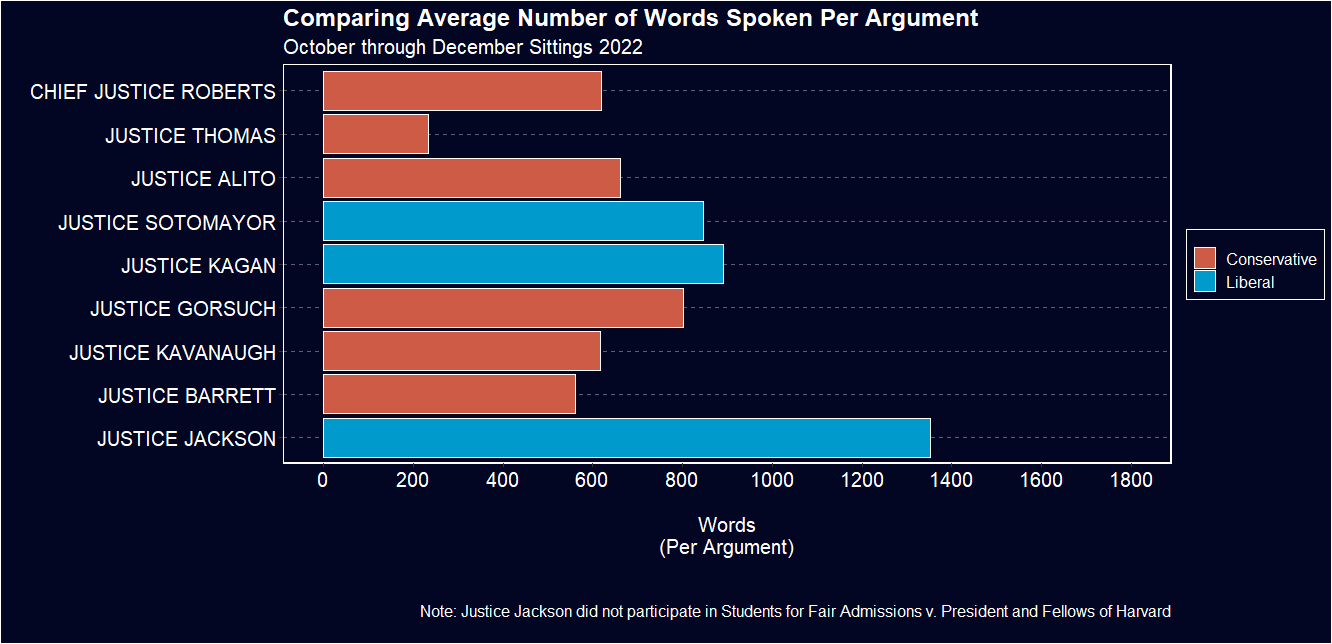
Click to enlarge. Graphic by Jake S. Truscott and Adam Feldman.
Interestingly, Jackson does not take nearly as many turns speaking as some of her colleagues.
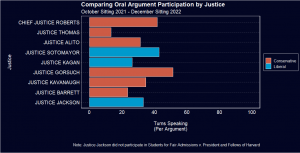
Click to enlarge. Graphic by Jake S. Truscott and Adam Feldman.
Jackson is behind Gorsuch, Sotomayor, and Chief Justice John Roberts in distinct talking turns. This suggests that when Jackson speaks, she tends to speak at some length, rather than contributing many short interjections. A prime example was her uninterrupted discussion of 14th Amendment history in Merrill, which took up more than three pages in the written transcript.
High engagement across all cases, especially the most divisive ones
Jackson has been particularly outspoken in the most significant cases argued so far this term. The next graph shows Jackson’s word counts (in blue) in each oral argument compared to each of the other justices.
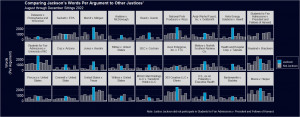
Click to enlarge. Graphic by Jake S. Truscott and Adam Feldman.
Jackson spoke perceptively more than any of the other justices in Merrill, Students for Fair Admissions v. University of North Carolina, United States v. Texas, 303 Creative v. Elenis, and Moore v. Harper, all of which are among the most high-profile cases on the court’s docket this term. She’s had the most words in 18 of 27 arguments so far, including approximately 2,700 in the UNC affirmative-action case.
When we total Jackson’s word counts across the term and compare these total words to each of the other justices’ totals, we see the following:
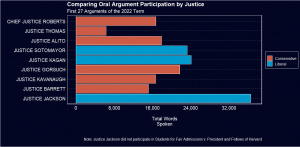
Click to enlarge. Graphic by Jake S. Truscott and Adam Feldman.
This graph shows that she has spoken a staggering 36,500 words, which is nearly 12,000 more than the justice with the next most words (Kagan) and is almost 30,000 more than the justice with the fewest words so far (Thomas). This is even more striking since Jackson recused herself from the other affirmative-action case, Students for Fair Admissions v. President & Fellows of Harvard College.
Comparing words counts of new justices
Another interesting comparison to draw is between Jackson and the other most recently confirmed justices: Gorsuch and Justices Brett Kavanaugh and Amy Coney Barrett. The following shows a smoothed graph of those four justices’ word counts for each of their first three months of oral arguments on the court.
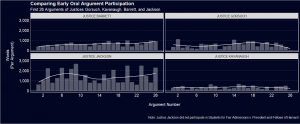
Click to enlarge. Graphic by Jake S. Truscott and Adam Feldman.
None of these other new justices are even in the same ballpark as Jackson. It is important to note, however, that the disparity is probably explained in part by the fact that Jackson joined the bench under the court’s new argument format. Gorsuch and Kavanaugh’s first arguments were conducted under the old format, in which most arguments were capped at one hour, so the justices did not have the chance to speak as many words as they do now. Barrett’s first arguments were during the early part of the pandemic when the court was hearing arguments over the phone.
Longer arguments mean more speaking time
As a result of the new format, we see an across-the-board increase in the justices’ oral argument word counts when compared to last term. Arguments also have gone on for longer than their allotted time limits.
With smoothed graphs similar to the previous one, we see that in the first three months of this term, almost all of the justices’ total word counts have increased.
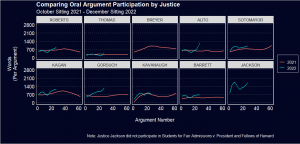
Click to enlarge. Graphic by Jake S. Truscott and Adam Feldman.
We also see that not only is Jackson outpacing the other justices in words spoken, but her word counts are significantly greater than Breyer’s from one term ago — and Breyer was not known for his succinctness.
Overall the justices spoke approximately 39,000 more words in the first 27 arguments this term than they did in the first three months of any term going back to 2011-12.
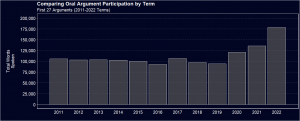
Click to enlarge. Graphic by Jake S. Truscott and Adam Feldman.
No strong correlation between spoken word-counts and written opinions
With Jackson’s impact on oral arguments thus far, one might wonder whether a justice’s level of engagement at an argument can indicate whether that justice is more likely to write the majority opinion or a dissent in the case. Based on our analysis of argument word counts from the past decade, the answer seems to be no.
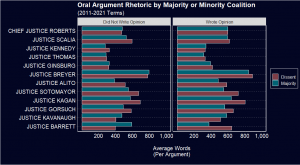
Click to enlarge. Graphic by Jake S. Truscott and Adam Feldman.
Since 2011, we see that the justices’ average words spoken in oral arguments is consistent whether they authored an opinion or not, as well as whether they were in the majority or minority.
With four months of oral arguments left and the court yet to issue any opinions in argued cases, we are left with many questions about the court and about Jackson’s role. Will Jackson provide the reliable liberal vote that many people expect from her? How will the ideas she expresses in oral arguments influence majority or separate opinions? Will we continue to see the justices use their time during arguments to express their own views in addition to asking questions? And will the trend of 6-3 ideological splits continue from last term, especially in the court’s most important cases? With all these uncertainties, one thing is clear at this early stage in the term: There is a real change in oral argument activity from the past, and with Jackson on the court, this change is here to stay.




